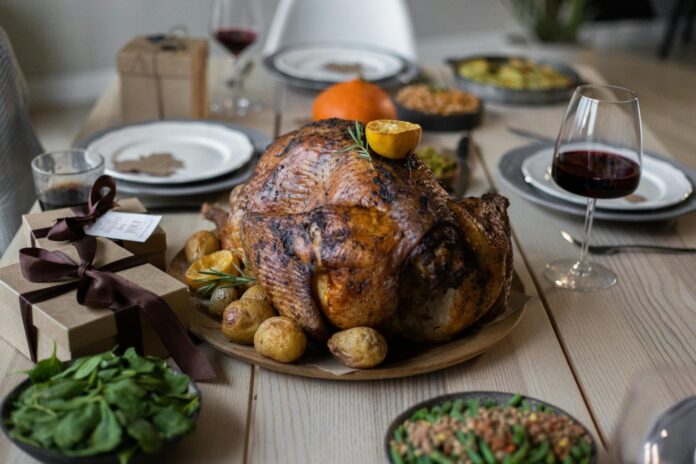Meals at Thanksgiving and other holidays serve as great social occasions for catching up with family and friends — and for the sake of all gathered, the culinary delights on the table should be delicious, sumptuous, and most importantly, safe.
Melissa Wright, director of Virginia Tech’s Food Producer Technical Assistance Network, and Lester Schonberger, associate Extension specialist, are both faculty members in the Virginia Tech College of Agriculture and Life Sciences‘ Department of Food Science and Technology and know exactly what you can do to reduce your risk of foodborne illness this holiday season.
“Of course, when handling food, the first rule is to wash your hands,” said Wright. “Use warm water and soap, and wash for at least 20 seconds. Dry your hands on a clean towel or disposable paper towel. Don’t use the same dish towel all day for all kitchen tasks.
“Remember that you may be cooking for a widely diverse group of people, and someone is likely to have an allergy or sensitivity,” said Wright. “Making cards to identify a dish and any potential allergens — wheat, milk, soy, peanuts, tree nuts, eggs, fish, shellfish, sesame — would be a thoughtful gesture to your guests.
“Measuring the internal temperature of cooked foods is an important part of food safety,” said Wright. “Measurements should be taken with a food thermometer. You can order one from Amazon today and have it in time for Thanksgiving.”
Wright cited the following recommended internal temperatures for holiday dishes:
- Poultry, including whole, parts and stuffing, should be cooked to an internal temperature of at least 165°F.
- A ham cooked from fresh or smoked should be cooked to an internal temperature of at least 145°F with a three-minute rest time before carving.
- A reheated, fully cooked ham should be cooked to an internal temperature of at least 140°F.
- Casseroles and leftovers should have an internal temperature of at least 165°F.
“Leftovers are one of the best parts of Thanksgiving, but once the meal is over, they need to be safely stored,” Schonberger said. “We say that you should make sure to keep food out of the danger zone, which is between 41°F and 135°F. It’s important that foods pass through this range as quickly as possible. Basically, keep hot foods hot and cold foods cold.”
Schonberger and Wright provided some other general tips including these:
If you are working with foods fresh from the oven or stove, once they are removed from the oven, you have about four hours to consume, store, or reheat. For foods that were kept in the refrigerator, that time increases to six hours. At that point, a decision must be made to eat, store, or throw out the remaining foods.
- When storing hot foods, it’s important to let them cool a bit before placing them in either the fridge or freezer.
- To properly cool foods, follow two-stage cooling guidelines. Stage 1 involves cooling food from 135°F to 70°F within the first two hours. Stage 2 involves cooling from 70°F to 41°F within the next four hours.
- The best way to ensure proper and safe cooling is to divide large amounts of leftovers into shallow containers.
A general rule of thumb, regardless of the type of food, is to toss leftovers within three to four days of being placed in the fridge — if your leftovers last that long.
“That might not seem long enough for leftovers,” Schonberger said. “But if you put enough food for meals onto plates and into the fridge and then store the rest of the leftovers in the freezer, they’ll safely keep for one to three months. However, keep in mind that the longer the food is in the freezer, the more the flavor will change due to increased moisture evaporation.
“As for how to store leftovers, seal food using airtight heavy-duty foil, plastic wrap, freezer paper, or a plastic storage bag,” Schonberger said.
Here are safe durations for storage for different kinds of Thanksgiving dishes:
- Casserole-style foods: Three to four days in the fridge and up to four months in the freezer
- Cooked bacon: Up to a week in the fridge and two to three months in the freezer
- Cooked fish: Three to four days in the fridge, four to six months in the freezer
- Cooked ham: Three to four days if sliced or a week if whole in the fridge, one to two months in the freezer
- Cooked meat: Three to four days in the fridge, two to three months in the freezer
- Cooked poultry: Three to four days in the fridge, four months in the freezer
- Macaroni and cheese: Three to four days in the fridge, up to two months in the freezer
If food has been stored for longer than the FDA-recommended times, here are a few warning signs that the food has gone bad:
- Has something growing on it
- Smells abnormal
- Has a weird taste
- Has a funny texture
“‘When in doubt, throw it out’ is a good rule of thumb,” Shonberger said. “If you’re not sure if the food is still good, err on the side of safety.”
Tools that can help guide include the FDA’s refrigerator and freezer storage chart and the USDA’s Foodkeeper app, which provides guidance on the safe handling, preparation, and storage of foods. “It’ll give you specific storage timelines for the refrigerator, freezer, and pantry for various food products,” Schonberger said.

